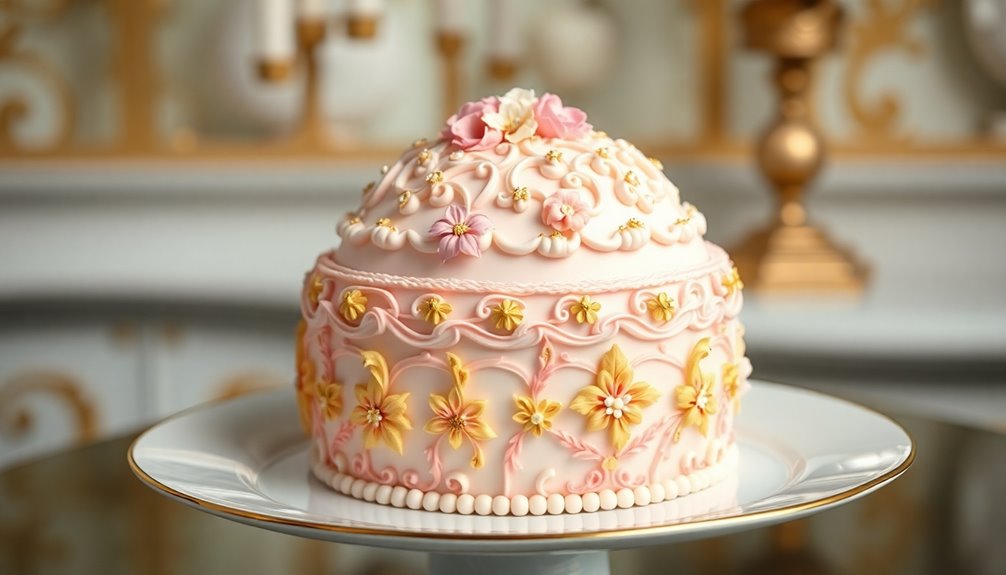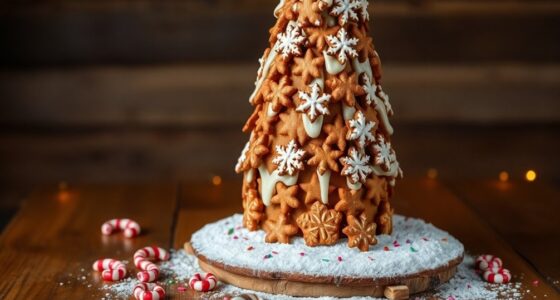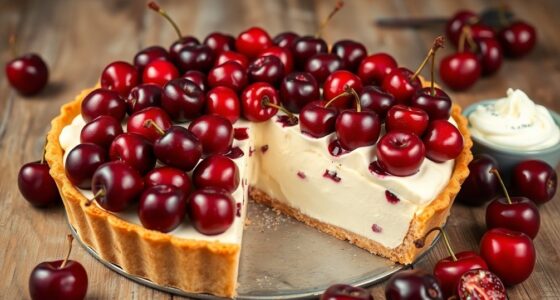Fabergé cakes are inspired by the luxurious Fabergé eggs, combining artistry and baking to create stunning centerpieces for special occasions. You bake layered round cakes, carve them into an oval shape, and coat them with chocolate ganache before covering with elegant fondant. Decorative elements like dusting powders and gold luster add a touch of opulence. These creations not only taste delightful but also showcase your creativity and skill. Discover the history and techniques behind these exquisite treats to elevate your baking.
History

The history of Fabergé egg cakes is deeply rooted in the opulence of the original Fabergé eggs, which were commissioned by Tsar Alexander III in 1885.
These exquisite creations were Easter gifts for Empress Maria Feodorovna, showcasing unparalleled craftsmanship and luxury. Only 50 imperial Fabergé eggs were made, with 43 still existing, each crafted from gold, silver, and precious gemstones.
The hidden surprises within these eggs highlighted their artistic value.
Today, the tradition of making decorative Fabergé egg cakes combines culinary art with the elegance and sophistication of the original designs.
These cakes have become a popular centerpiece for celebrations, especially during Easter, symbolizing creativity in baking and a rich connection to the illustrious history of the Fabergé eggs.
Recipe

Creating a Fabergé Egg Cake is a delightful baking project that combines artistry and culinary skill. This stunning cake, inspired by the luxurious Fabergé eggs, is perfect for special occasions and will impress your guests with its intricate design and rich flavors.
The process begins with baking two batches of round cakes which will form the base of your egg shape. These cakes are then carefully sculpted and decorated, transforming them into a work of art that's just as delicious as it's beautiful.
To achieve the luxurious look of a Fabergé egg, you'll need to pay attention to the details, from the smooth ganache coating to the elegant fondant finish. This cake not only looks impressive but also offers a delightful taste that will leave everyone wanting more.
Gather your ingredients and prepare for a fun and creative baking experience that will culminate in a stunning centerpiece for your celebration.
Ingredients:
- 2 batches of cake batter (enough for two 5" and two 6" round cakes)
- Buttercream frosting
- Chocolate ganache (for coating)
- Rolled fondant
- Dusting powders (various colors)
- Edible glue
- Gold luster dust
- Small egg template (for decoration)
- Food-safe paintbrush (for painting plaque)
Cooking Instructions:
Begin by baking two 5" round cakes and two 6" round cakes, ensuring they're each 2" high and level when cooled.
Once cooled, stack the cakes with buttercream frosting in between each layer. Use the printed egg template to carve the stacked cakes into an oval shape, smoothing the transitions as you go.
After sculpting the cake, apply a layer of chocolate ganache for a smooth base, allowing it to set before draping with rolled fondant.
Use the dusting powders to add color and create a painted plaque with your smaller egg template. Finally, finish the cake by applying gold luster dust and using edible glue to attach any additional decorative elements.
Extra Tips:
When baking your cakes, ensure that your oven temperature is accurate for even baking.
Leveling the cakes is crucial for a smooth finish, so take your time with this step. If you're new to working with fondant, practice rolling it out to the desired thickness before covering your cake.
Additionally, consider making the ganache a day in advance to allow it to cool and thicken properly, making it easier to apply.
Don't be afraid to get creative with your decorations; the more personal touches you add, the more unique your Fabergé Egg Cake will be!
Cooking Steps

To get started on your Fabergé cake, gather all your baking ingredients and prepare your cake layers.
Once your cakes are baked and cooled, you'll shape them to create that iconic oval design.
Don't forget to set up a sturdy base structure to support your masterpiece!
Step 1. Gather Baking Ingredients

Gathering the right baking ingredients is crucial for crafting your stunning Fabergé egg cake. Start by collecting two 5" round cakes and two 6" round cakes, each 2" high. These will form the base of your cake.
Prepare a 14" square board and secure it with five long wooden dowels (1" diameter) to ensure stability when stacking. Don't forget to have melted chocolate on hand for coating the dowels and board, maintaining food safety between layers.
Next, gather essentials like buttercream, ganache, fondant, and edible dusts for those gorgeous finishing touches.
Finally, download a free PDF egg template to help shape your cake perfectly. With all these ingredients ready, you'll be set to create a masterpiece!
Step 2. Add Cake Layers

Start by baking two 5" round cakes and two 6" round cakes, each 2" high, according to your chosen recipe.
Once the cakes have cooled, level the tops to achieve an even stacking surface.
Next, stack the layers, placing a generous layer of buttercream between each cake.
Position the 6" cakes on the bottom and the 5" cakes on top for stability.
To ensure your cake layers stay secure, insert long wooden dowels into the stacked cakes.
This will prevent any sliding or collapsing as you continue working.
Allow the stacked cakes to set for a short time; this helps them hold their shape while you prepare for the exciting sculpting and decorating steps ahead.
Step 3. Shape the Cake Layers

Once your cake layers are stacked and secured, it's time to shape them into the iconic egg form.
Start by baking two 5-inch round cakes and two 6-inch round cakes, each 2 inches high. After they've cooled, level the layers for even stacking.
Use a printed egg template to trace and cut the cake layers into an oval silhouette, adjusting as needed to achieve your desired shape.
Once you've sculpted the cake into a Faberge Egg, smooth out any rough edges for a polished appearance.
To keep the carved cake stable, refrigerate it briefly before you continue with the covering and decorating steps. This will ensure your creation holds its shape beautifully!
Step 4. Create the Base Structure

With the Faberge Egg shape now complete, it's time to create a sturdy base for your cake.
Start by baking two 5" round cakes and two 6" round cakes, each 2" high, using a trusted recipe for rich flavor.
Once baked, brush the wooden dowels and square board with melted chocolate to promote food safety before stacking.
Layer the cakes with buttercream, placing the 6" cakes on the bottom and the 5" cakes on top, ensuring everything is level.
Use a printed egg template to carve the stacked cakes into an oval shape, adjusting as needed for a smooth transition.
Finally, cover the sculpted cake with a ganache layer, smoothing it out with an acetate sheet before refrigerating for 15-20 minutes.
Step 5. Pour Warm Chocolate Ganache
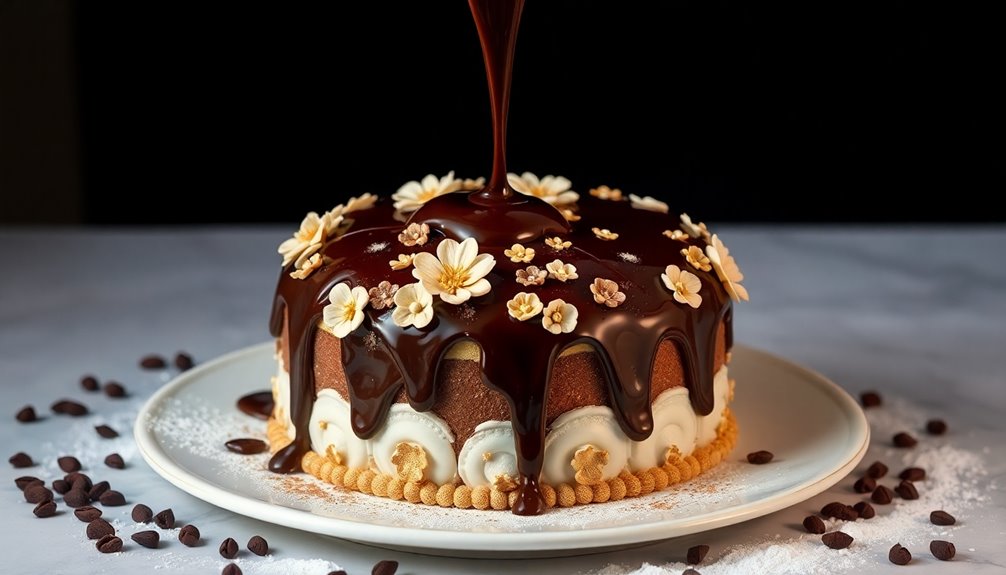
Pouring warm chocolate ganache over your sculpted cake is a crucial step that enhances its luxurious appearance and flavor.
To make your ganache, heat equal parts heavy cream and chocolate in a saucepan until the chocolate melts and the mixture is smooth. Make sure to stir gently with a whisk to eliminate lumps, then allow it to cool slightly.
Pour the ganache over your cake while it's still warm but not hot, ensuring it coats evenly without melting any decorations underneath. If you prefer a thicker ganache, increase the chocolate ratio; for a thinner consistency, add more cream.
Once poured, let the ganache set at room temperature or refrigerate briefly for a firmer finish, depending on your desired texture.
Final Thoughts
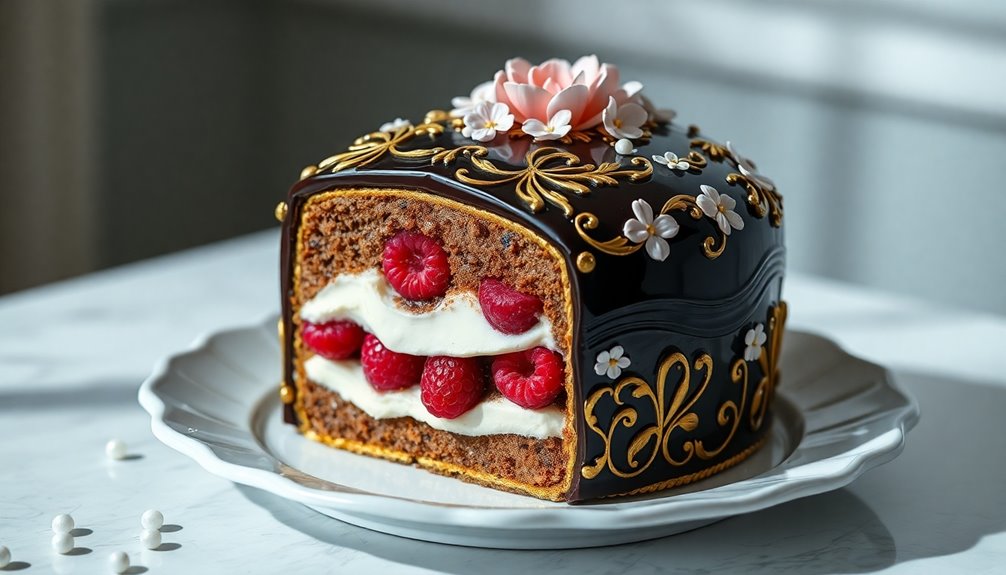
As you consider the elegance and artistry of Fabergé egg cakes, it's clear they represent more than just desserts; they embody a celebration of creativity and craftsmanship.
These stunning creations, inspired by the luxurious designs of original Fabergé eggs, captivate with their intricate details and vibrant colors. When you coat the cake with fondant or airbrush it to perfection, you're not just decorating; you're making a statement.
Fabergé egg cakes shine in competitions, showcasing bakers' skills and innovation. They also serve as gorgeous centerpieces for special occasions, especially Easter.
With the rise of social media, more home bakers are inspired to try their hand at these designs, sharing their unique interpretations with the world.
Enjoy the artistry!
Frequently Asked Questions
How Much Is a Fabergé Worth?
The worth of a Fabergé egg can reach astonishing heights, sometimes up to $33 million, depending on its historical significance and craftsmanship.
You'll find that only 43 of the original 50 imperial eggs exist, adding to their rarity and value.
Each egg represents years of labor and artistry, often containing hidden surprises.
If you're considering investing, keep in mind the appreciation in the market, as some pieces fetch millions at auctions.
What Is the Point of a Fabergé Egg?
The point of a Fabergé egg lies in its exquisite craftsmanship and historical significance.
Each egg represents a symbol of love, luxury, and artistry, originally created for the Russian imperial family.
You'll discover intricate designs and hidden surprises that reflect the opulence of that era.
Collectors and historians alike value these unique pieces, as they embody the cultural heritage of Russia and the exceptional skill of the artisans who crafted them.
Is Fabergé Still in Business?
Yes, Fabergé is still in business, and it's quite fascinating that the brand produces limited-edition pieces, with only a few dozen crafted each year.
You'll find that since its revival in the 1990s, Fabergé has focused on high-end jewelry and luxury items, often inspired by the iconic eggs.
Owned by Gemfields, they uphold a commitment to responsibly sourced gemstones, blending traditional craftsmanship with modern design to captivate luxury clientele.
What Fabergé Item Sold for 9.6 Million Dollars?
You might be surprised to learn that the Fabergé item that sold for $9.6 million is the Imperial Blue Egg.
Crafted in 1887 for Tsar Alexander III, this exquisite piece showcases stunning craftsmanship with its gold and blue enameled exterior, adorned with diamonds.
Inside, it hides a golden yolk that reveals a miniature crown and ruby pendant.
Its historical significance and rarity make it a highly coveted collectible among art enthusiasts.
